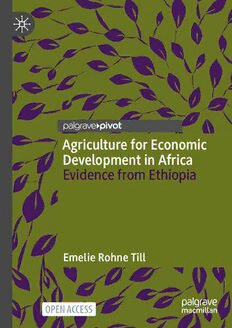
Agriculture for Economic Development in Africa. Evidence from Ethiopia PDF
Preview Agriculture for Economic Development in Africa. Evidence from Ethiopia
Agriculture for Economic Development in Africa Evidence from Ethiopia Emelie Rohne Till Agriculture for Economic Development in Africa Emelie Rohne Till Agriculture for Economic Development in Africa Evidence from Ethiopia Emelie Rohne Till Department of Economic History Lund University Lund, Sweden ISBN 978-3-031-07900-9 ISBN 978-3-031-07901-6 (eBook) https://doi.org/10.1007/978-3-031-07901-6 © The Author(s) 2022. This book is an open access publication. Open Access This book is licensed under the terms of the Creative Commons Attribution 4.0 International License (http://creativecommons.org/licenses/by/4.0/), which permits use, sharing, adaptation, distribution and reproduction in any medium or format, as long as you give appropriate credit to the original author(s) and the source, provide a link to the Creative Commons licence and indicate if changes were made. The images or other third party material in this book are included in the book’s Creative Commons licence, unless indicated otherwise in a credit line to the material. If material is not included in the book’s Creative Commons licence and your intended use is not permitted by statutory regulation or exceeds the permitted use, you will need to obtain permission directly from the copyright holder. The use of general descriptive names, registered names, trademarks, service marks, etc. in this publication does not imply, even in the absence of a specific statement, that such names are exempt from the relevant protective laws and regulations and therefore free for general use. The publisher, the authors and the editors are safe to assume that the advice and information in this book are believed to be true and accurate at the date of publication. Neither the publisher nor the authors or the editors give a warranty, expressed or implied, with respect to the material contained herein or for any errors or omissions that may have been made. The publisher remains neutral with regard to jurisdictional claims in published maps and institutional affiliations. This Palgrave Macmillan imprint is published by the registered company Springer Nature Switzerland AG. The registered company address is: Gewerbestrasse 11, 6330 Cham, Switzerland A cknowledgments I would like to gratefully acknowledge Martin Andersson, Tobias Axelsson, Jutta Bolt, and Agnes Andersson Djurfeldt (Lund University), as well as Christopher Cramer (SOAS University of London) and Ewout Frankema (Wageningen University). Thank you for your helpful advice and com- ments on chapters of this book and on my doctoral thesis, which form the foundation for the material and research in this book. The work was supported by research funding from the Marianne and Marcus Wallenberg Foundation (MMW2014.0151) and Riksbankens Jubileumsfond (P18-0603:1). v k eywords Agricultural transformation • Economic growth • Sub-Saharan Africa • Ethiopia vii c ontents Part I 1 1 Introduction 3 Aim and Contribution 4 Case Study Approach 5 References 6 2 The Role of Agriculture in Economic Development 9 Agriculture for Development 10 Agricultural Development 13 References 14 3 The Role of the State in Agricultural Development 19 Agricultural Policies 21 Public Spending on Economic and Agricultural Development 22 References 24 4 Sustained Growth and Development in Sub-S aharan Africa 29 References 32 ix x CONTENTS Part II 35 5 Case Study Context: Ethiopia 37 Economic Context 38 Political Context 41 Policy Context 45 Agricultural Context 46 Agricultural and Economic Growth in the Twenty-First Century 49 References 53 Part III 61 6 Methodology 63 Data 64 Method 68 References 72 7 SIO Multiplier Analysis 77 Discussion of Results 84 References 87 8 Concluding Remarks 91 References 95 Index 97 A A bout the uthor Emelie Rohne Till, Ph.D., is a Lecturer in Economic History at Lund University, Sweden. Her main area of expertise includes the role of struc- tural transformations in the development of low-income countries, as well as the role of the agricultural sector in this process. Her Ph.D. thesis stud- ied this subject through a case study of Ethiopia’s recent and rapid eco- nomic growth and was set at the intersection of economic history and development economics. In regards to teaching, her main fields of experi- ence include Asian economic history, development studies, and agricul- tural economics. Prior to receiving her Ph.D., Dr. Rohne Till worked as a consultant at a management consultancy specialized in countries in transi- tion in the Middle East and North Africa. This work involved both quan- titative and qualitative research on topics such as women’s role in peace and security, public service delivery and public administration reform, and evaluations of humanitarian programs in the MENA region. Dr. Rohne Till holds a Ph.D. in Economic History from Lund University, a Master’s Degree in International Economics with a focus on China from Lund University, and a Bachelor’s Degree in Development Studies from Lund University. xi l f ist of igures Fig. 5.1 GDP per capita growth and population growth (annual %; left axis) and GDP per capita (2011 constant USD, PPP; right axis). (Source: Author’s calculation based on PWT 2020 (Feenstra et al., 2015) and TED 2020 (The Conference Board, 2020)) 40 Fig. 5.2 Agricultural public spending as a share of total public spending, Ethiopia and African average 1990–2018. (Source: ReSAKSS (2021). Note: The dashed thin line represents the Maputo commitment since 2003 to spend minimum 10%) 45 Fig. 5.3 Labor productivity growth per sector (annual % change of value added per worker). (Source: Author’s calculation based on World Bank (2021)) 50 Fig. 5.4 Labor productivity per sector (value added per worker in constant 2010 US dollars). (Source: Author’s calculation based on World Bank (2021)) 52 xiii
